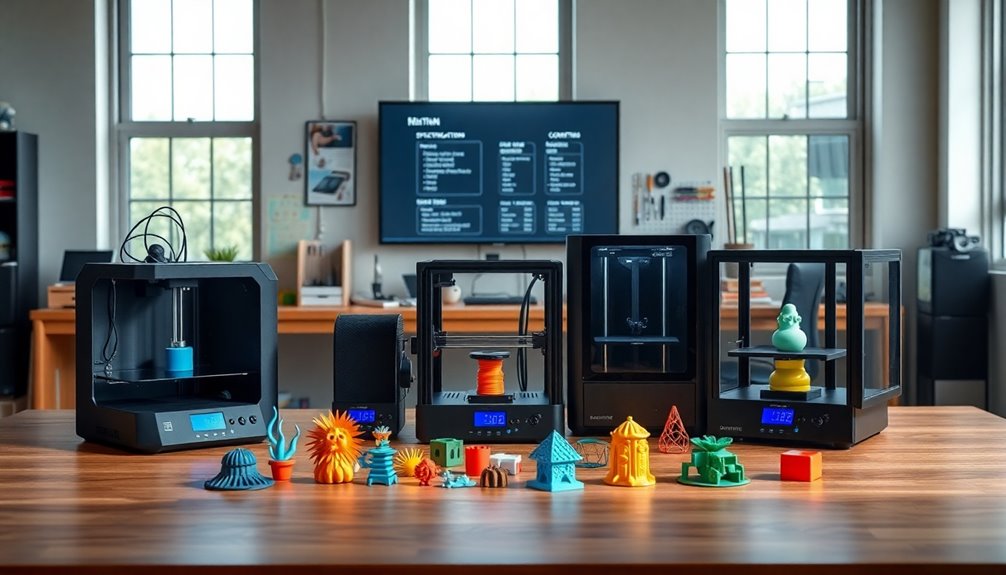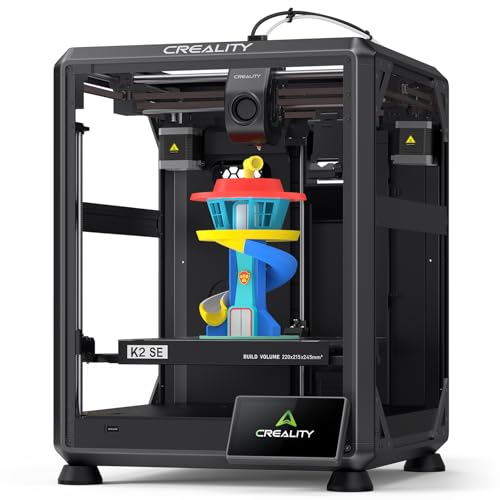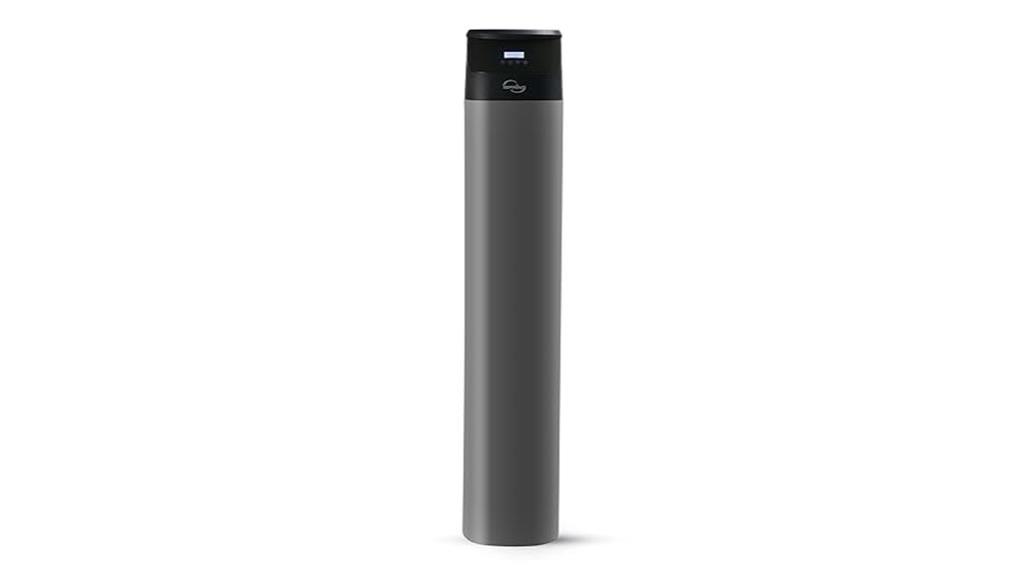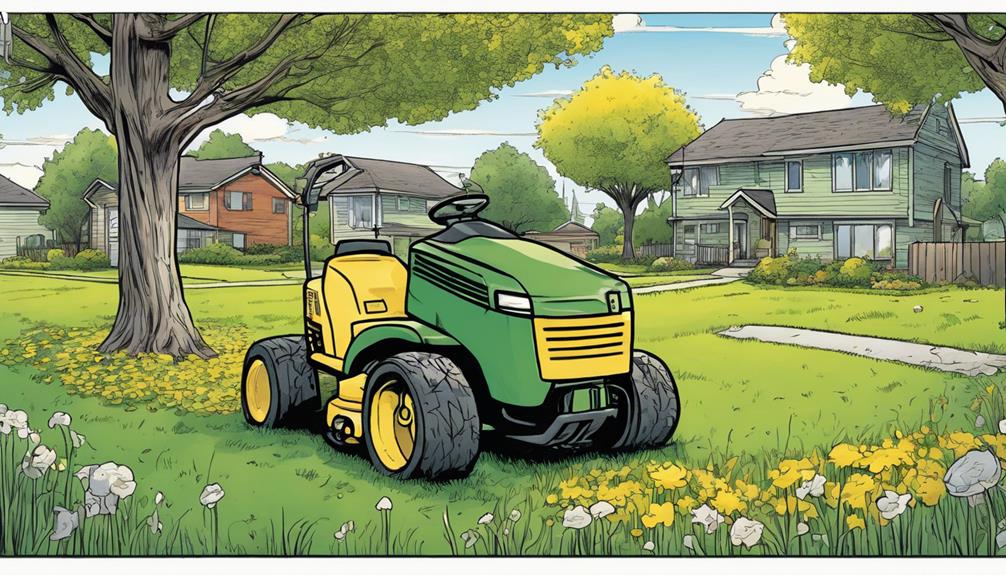I've looked into the 15 best 3D printers of 2025, and I'm excited to share some fantastic options that fit every budget and need. For beginners, the FLASHFORGE Adventurer 5M stands out with its automatic printing features. If speed's what you're after, the Creality K1C offers impressive performance. Meanwhile, the QIDI PLUS4 balances speed with user-friendly features. For larger projects, I recommend the Longer LK5 Pro. Each printer has its pros and cons, which I can break down further as you explore the options tailored for you.
Key Takeaways
- Consider the FLASHFORGE Adventurer 5M for beginners seeking user-friendly features with automatic printing and ease of setup within a smaller print size.
- For high-speed performance, the Creality K1C is ideal, offering 600mm/s printing speeds and AI monitoring, but requires regular maintenance.
- The Creality K2 Plus excels in multi-color printing with a large build volume, though users report assembly quality issues.
- ELEGOO Neptune 3 Pro provides a quick setup with low noise operation, but be prepared for potential nozzle clogs and frequent bed leveling.
- If you need diverse material compatibility and high precision, consider the QIDI PLUS4, although it comes with a higher initial investment.
FLASHFORGE Adventurer 5M 3D Printer
The FLASHFORGE Adventurer 5M 3D Printer stands out as an excellent choice for beginners and those looking to upgrade their printing capabilities, thanks to its one-click automatic printing feature that guarantees flawless first layers. Its fully auto-leveling system simplifies setup, while the high-speed performance of 600mm/s means I can print faster without sacrificing quality. The 280°C direct extruder and detachable nozzle make material changes a breeze, and the dual-fan nozzles provide even cooling for better results. I appreciate the user-friendly touchscreen interface and plug-and-play setup, which makes getting started easy. Although the print bed size might limit larger projects, overall, it's a fantastic printer that combines speed, quality, and accessibility for users at any skill level.
Best For: The FLASHFORGE Adventurer 5M 3D Printer is best for beginners and intermediate users seeking a reliable and efficient 3D printing experience.
Pros:
- One-click automatic printing ensures consistent bed leveling and perfect first layers, making it easy for users with minimal experience.
- High-speed performance of up to 600mm/s and a 280°C direct extruder allows for fast and efficient printing without compromising quality.
- User-friendly touchscreen interface and plug-and-play setup simplify the initial assembly and operation, enhancing the overall user experience.
Cons:
- Limited slicing software options, requiring the use of proprietary Flashprint software for .GX file formats.
- Potential issues with filament feeding and nozzle clogs after multiple prints may require users to be cautious during operation.
- Small print bed size (maximum 220x220x220mm) restricts the ability to execute larger projects.
Creality K1C 3D Printer (2024 New Version)
Looking for a 3D printer that combines speed and ease of use? The Creality K1C 3D Printer (2024 New Version) might just be what you need. With a staggering printing speed of 600mm/s, it's twelve times faster than typical models. I love how it supports high-temperature filaments, making it versatile for various projects. Setting it up is a breeze—it's fully assembled and ready to print in just three minutes! Plus, the auto calibration features take the hassle out of setup. The integrated AI camera is another standout, allowing for real-time monitoring. While regular maintenance is essential for peak performance, the community support and upgrade options make it a great choice for both novices and experienced makers alike.
Best For: The Creality K1C 3D Printer is best for both beginners and experienced users looking for a high-speed, versatile 3D printing solution with minimal setup time.
Pros:
- Exceptional printing speed of 600mm/s, significantly reducing print times.
- Easy setup with plug-and-play functionality and auto calibration features.
- Advanced monitoring with an AI camera for real-time failure recognition.
Cons:
- Regular maintenance is required to ensure optimal performance and print quality.
- Initial assembly and adjustments may be necessary for stable operation.
- The learning curve may pose challenges for new users unfamiliar with 3D printing.
Creality K2 Plus Combo 3D Printer
For enthusiasts who crave versatility in their printing projects, the Creality K2 Plus Combo 3D Printer stands out with its impressive multi-color printing capability, supporting up to 16 colors through four CFS units. With a maximum printing speed of 600mm/s and a spacious build volume of 350mm³, it's designed for efficiency and creativity. The printer features automatic leveling with dual motorized Z-axes, ensuring precision and stability. Users appreciate the quality output, ease of assembly, and compatibility with various materials like PLA and ABS. However, some have reported challenges with assembly quality and customer support. Overall, the K2 Plus Combo is a solid choice for those looking to elevate their 3D printing experience with advanced features.
Best For: The Creality K2 Plus Combo 3D Printer is best for 3D printing enthusiasts looking for a versatile machine capable of multi-color printing and high-speed performance.
Pros:
- High printing speed of up to 600mm/s, enabling efficient production.
- Supports a wide range of materials, including PLA, ABS, and PETG.
- Features automatic leveling and dual Z-axes for enhanced stability and precision.
Cons:
- Assembly quality issues reported, including unaligned components.
- Customer support responsiveness has been criticized, leading to unresolved issues.
- Delivery experiences vary, with some users encountering damage or inadequate instructions.
ELEGOO Neptune 3 Pro FDM 3D Printer
With its user-friendly design and advanced auto bed leveling, the ELEGOO Neptune 3 Pro FDM 3D Printer stands out as an ideal choice for beginners and hobbyists alike. The pre-assembled components make setup a breeze, and I found the included toolkit quite handy. Its dual-gear direct extruder and high-precision sensor guarantee strong extrusion and accurate prints. I love that it supports various materials like PLA and ABS, giving me plenty of creative options. Plus, the silent stepper motors keep noise levels low, so I can print without distraction. Users rave about its print quality, but I recommend keeping an eye on bed leveling and nozzle clogs. Overall, it's a reliable and efficient printer that truly satisfies my needs.
Best For: Beginners and hobbyists looking for an easy-to-use 3D printer with reliable performance and quality prints.
Pros:
- User-friendly design with pre-assembled components and minimal setup required.
- Versatile material compatibility allows printing with PLA, TPU, PETG, and ABS.
- Low noise operation thanks to silent stepper motors, making it suitable for home environments.
Cons:
- Potential nozzle clogs may occur and require regular maintenance or replacement.
- Regular bed leveling is necessary to ensure optimal print quality and accuracy.
- Learning curve for troubleshooting might be needed, especially for new users.
FLASHFORGE Adventurer 5M 3D Printer
The FLASHFORGE Adventurer 5M 3D Printer stands out for its exceptional speed and efficiency, making it an ideal choice for home users who want to produce high-quality prints without the long wait. With a max travel speed of 600mm/s and rapid heating capabilities, it impressively reduces printing time by up to 70%. The dual-sided PEI platform and automatic leveling features guarantee a hassle-free setup, while the diverse nozzle options allow for precision in every project. Plus, the Smart App Flash Maker lets me monitor prints remotely, adding to its convenience. Overall, this printer combines performance and user-friendly design, making it a top pick for anyone looking to enhance their 3D printing experience.
Best For: The FLASHFORGE Adventurer 5M 3D Printer is best for home users seeking a high-speed, efficient 3D printing solution with user-friendly features.
Pros:
- Exceptional Speed: Max travel speed of 600mm/s reduces printing time by up to 70%.
- User-Friendly Features: Automatic leveling and dual-sided PEI platform make setup and use hassle-free.
- Remote Monitoring: Smart App Flash Maker allows for real-time monitoring and adjustments.
Cons:
- Learning Curve: Initial setup and software navigation may require time and patience.
- Manual Bed Leveling: Requires careful manual adjustment for optimal first layer prints.
- Compatibility Considerations: Specific settings needed for different filament types, which may require additional research.
Creality K1C 3D Printer with AI Camera
Looking for a cutting-edge 3D printer that combines speed and intelligence? The Creality K1C 3D Printer is a game-changer. With its incredible speed of up to 600mm/s and 20,000mm/s² acceleration, it's twelve times faster than standard models. The clog-free direct extruder and robust tri-metal nozzle let you work with high-temp materials like carbon fiber filaments. Plus, the enclosed chamber guarantees peak thermal regulation. I love the hands-free auto calibration and AI camera that monitors for issues in real-time, enhancing my printing experience. It operates quietly and purifies the air, making it perfect for home use. Overall, the K1C delivers exceptional print quality and ease of use, making it a top choice for any enthusiast.
Best For: Enthusiasts and professionals seeking a high-speed, user-friendly 3D printer capable of handling advanced materials.
Pros:
- Exceptional Speed: Capable of printing at up to 600mm/s, significantly reducing print times.
- Advanced Features: Equipped with AI camera for real-time monitoring and hands-free auto calibration for ease of use.
- Air Quality Management: Operates quietly and includes air purification for a comfortable home environment.
Cons:
- Initial Noise Issues: Some users reported noise during the initial setup that may need addressing.
- Filament Feed Challenges: A few users experienced minor difficulties with filament feeding.
- Limited Support for Non-Standard Filaments: While it supports a range of materials, some unique filaments may require additional adjustments for optimal results.
Creality 3D Printer K1 SE, Fully Assembled FDM Printer for Kids and Beginners
For kids and beginners venturing into the world of 3D printing, the Creality 3D Printer K1 SE stands out with its fully assembled design and auto-calibration feature. In just three minutes, you can set it up and start printing, thanks to its plug-and-play operation. With a maximum speed of 600mm/s and a print size of 250x220x220mm, it's perfect for creating various projects. I appreciate that it handles multiple filament types, including TPU and ABS, and the ceramic heater guarantees quick melting. Plus, the integrated Creality cloud makes design and printing easy. While most users praise its ease of use, some reported minor issues. Overall, it's a solid choice for those just starting their 3D printing journey.
Best For: The Creality 3D Printer K1 SE is best for kids and beginners looking for an easy and quick introduction to 3D printing.
Pros:
- User-friendly setup with auto-calibration and plug-and-play operation.
- Capable of printing with multiple filament types, including TPU and ABS, with high print quality.
- Compact design and quiet operation, making it suitable for home use.
Cons:
- Some users reported issues with clogging and motherboard fan failures.
- Mixed reviews on the completeness of the pre-assembled version, with missing enclosure parts noted.
- Optimal printing settings may require adjustments, which can be a learning curve for beginners.
Creality K1 Max Upgraded 3D Printer
With its impressive max speed of 600mm/s and advanced AI LiDAR technology, the Creality K1 Max Upgraded 3D Printer stands out as an ideal choice for both beginners and seasoned professionals alike. The large print size of 11.81 inches on each side allows for versatile projects, while the dual-gear direct extruder handles high-temperature filaments up to 300℃ effortlessly. I love the fully automatic leveling and real-time monitoring features that guarantee precise prints every time. Plus, the dual cooling system prevents stringing and warping. After minimal setup, I found it easy to plunge into printing, and the 24/7 customer support is a bonus. Overall, the K1 Max offers fantastic value, particularly for those willing to explore and tweak their settings.
Best For: The Creality K1 Max Upgraded 3D Printer is best for both beginners and professionals looking for high-speed, high-quality 3D printing with advanced features.
Pros:
- Fully automatic leveling and real-time monitoring ensure precise prints.
- Large printing size of 11.81 inches allows for versatile project options.
- 24/7 customer support provides assistance whenever needed.
Cons:
- Users may experience nozzle clogging issues related to settings rather than printer defects.
- Some users reported extruder performance issues that may require upgrades.
- Optimal performance may depend on using a sturdy table and proper filament management.
3D Printer for Kids with PLA Filament Set & Wi-Fi Control
Ideal for young creators and families, the 3D Printer for Kids combines ease of use with innovative features like Wi-Fi control and voice commands. I love how it comes with an 8 PLA filament set, perfect for sparking creativity without the hassle. The smart app allows for one-click printing on iOS, Android, or Windows, making it simple for anyone to start a project. With over 1,500 digital designs and weekly updates, the possibilities are endless. The quick-release nozzle makes swapping filaments a breeze, and the fully enclosed structure guarantees safety. While some users faced minor app issues, the overall experience was positive, especially with real-time monitoring and customer support available. It's a fantastic entry-level option for kids and families!
Best For: This product is best for young creators and families looking to introduce kids to the world of 3D printing in a safe and user-friendly way.
Pros:
- Easy to use with a smart app for one-click printing on multiple platforms.
- Includes a variety of filaments and access to over 1,500 digital designs for endless creativity.
- Safety features like a fully enclosed structure and voice commands enhance accessibility for all ages.
Cons:
- Some users reported app crashes and connectivity issues that may require troubleshooting.
- Initial setup may have minor challenges, particularly for those unfamiliar with technology.
- Limited advanced features may not satisfy experienced users as they grow in 3D printing skills.
FLASHFORGE Adventurer 5M 3D Printer
The FLASHFORGE Adventurer 5M 3D Printer shines as an excellent choice for both beginners and seasoned users who crave a hassle-free printing experience. With its fully automatic leveling system, I found setup to be a breeze, taking me just about 15 minutes. The CoreXY all-metal structure offers impressive speeds of up to 600mm/s while maintaining exceptional print quality. I appreciate the quick-detachable nozzles, allowing for easy maintenance without any tools. While I did encounter some minor software hiccups, the Orca slicer is a valuable feature for managing multiple prints. Overall, for $300-$400, this printer delivers excellent value and performance, making it a strong contender for anyone looking to upgrade their 3D printing game.
Best For: The FLASHFORGE Adventurer 5M 3D Printer is best for both beginners and experienced users seeking an user-friendly and efficient 3D printing solution.
Pros:
- Fully automatic leveling system simplifies setup and improves first layer quality.
- High-speed printing capabilities (up to 600mm/s) paired with excellent print quality.
- Quick-detachable nozzles allow for easy maintenance and switching without tools.
Cons:
- Some users report limited functionality and issues with software and firmware.
- Remote monitoring features are not as robust, and the preferred Orca slicer lacks wireless print sending.
- Support experiences can vary, with some finding tech support unhelpful.
Tina2S 3D Printer for Beginners and Kids
For those just dipping their toes into the world of 3D printing, the Tina2S 3D Printer stands out as an excellent choice, especially for beginners and kids. It comes fully assembled, making it ready to use right out of the box. With features like WiFi Cloud Printing and auto leveling, you won't have to worry about complicated setups. The heated spring steel build plate guarantees prints come out flawlessly, and the compact size is perfect for smaller projects. I love that it operates quietly, allowing me to focus on my creations without distraction. Plus, Tina2S offers responsive customer support, which is a huge plus for anyone just starting their 3D printing journey. It's truly a fantastic investment!
Best For: Beginners, kids, and novice users looking for an easy-to-use 3D printer that delivers high-quality prints without complicated setups.
Pros:
- Fully assembled and ready to use out of the box, minimizing setup time.
- Features auto leveling and a heated build plate for high print quality and easy removal.
- Quiet operation and responsive customer support enhance the overall user experience.
Cons:
- Limited print size may not suit larger projects or advanced users.
- Some users report drawbacks with the built-in slicing software.
- Mixed reviews on software compatibility with certain programs, which could hinder some users.
QIDI PLUS4 3D Printer
Looking for a 3D printer that combines high-speed performance with versatile material compatibility? The QIDI PLUS4 might just be what you need. With a print size of 12 x 12 x 11 inches and a max speed of 600 mm/s, it's designed for efficiency. I love the high-temp hotend that heats up to 370°C, allowing me to work with various filaments like PPS-CF and ABS. The advanced core XY structure and active chamber heating system minimize warping, ensuring great results. Plus, setup takes just 10 minutes! I appreciate the remote monitoring feature and easy maintenance with clear instructions. Overall, the QIDI PLUS4 offers excellent performance and value, making it a fantastic choice for any enthusiast.
Best For: The QIDI PLUS4 3D Printer is best for enthusiasts and professionals looking for a high-speed, versatile 3D printing solution with excellent material compatibility.
Pros:
- High-speed printing with a max speed of 600 mm/s enhances productivity.
- Versatile filament compatibility allows for the use of a wide range of materials, including high-temp options.
- User-friendly setup and remote monitoring features provide convenience and ease of use.
Cons:
- Initial cost may be higher compared to entry-level 3D printers.
- Heated chamber may require additional energy, potentially increasing operating costs.
- Limited support for very complex geometries compared to some specialized high-end models.
Longer LK5 Pro 3D Printer (11.8×11.8×15.7in)
With a spacious build size of 11.8 x 11.8 x 15.7 inches, the Longer LK5 Pro 3D Printer is perfect for enthusiasts and beginners who want to tackle larger projects without breaking the bank. I love how it combines speed and precision, achieving a printing speed of 180mm/s with a 0.1mm accuracy. The printer's compatibility with various materials like PLA, ABS, and TPU opens up creative possibilities. Plus, the 90% pre-assembled design makes setup a breeze, though I found some assembly tips online helpful. The upgraded components, like the silicon carbide platform, enhance the print quality. Additionally, the filament detection feature guarantees my prints can resume after interruptions. Overall, the LK5 Pro offers incredible value for anyone looking to expand their 3D printing experience.
Best For: The Longer LK5 Pro 3D Printer is best for both beginners and enthusiasts looking for an affordable option with a large build size and versatile material compatibility.
Pros:
- Comes with SD card and USB adapter for easy file transfer.
- Large printing space for the price, allowing for bigger projects.
- Sturdy construction and generally good print quality with advanced features.
Cons:
- Manual bed leveling can be cumbersome, though an auto-leveling sensor is optional.
- Documentation quality varies, leading to potential confusion during assembly.
- Initial issues with heatbed warping and software compatibility reported by some users.
QIDI MAX3 High-Speed 3D Printer
The QIDI MAX3 High-Speed 3D Printer stands out for its impressive maximum print speed of 600mm/s, making it an ideal choice for professionals and hobbyists who need to produce intricate designs quickly. I love how its CoreXY structure and all-metal frame guarantee stability, allowing for high precision in my prints. The printer supports a wide range of materials, from standard options like PLA to high-performance filaments like PA12-CF, giving me versatility for various projects. The enclosed heating chamber reaches 65℃, which is great for minimizing warping. Plus, the user-friendly QIDIslicer software makes slicing a breeze. Overall, I've found the QIDI MAX3 to be a reliable and efficient choice for anyone serious about 3D printing.
Best For: The QIDI MAX3 High-Speed 3D Printer is best for professionals and hobbyists seeking a reliable and efficient 3D printing solution for intricate designs and prototypes.
Pros:
- High print speed of 600mm/s for quick production of detailed models.
- Versatile material compatibility including high-performance filaments like PA12-CF and standard materials like PLA.
- User-friendly software (QIDIslicer) that simplifies the slicing process for users of all experience levels.
Cons:
- Some design flaws noted, such as issues with the top cover fitting.
- Chamber heating is slower compared to bed heating, which may affect print setups.
- Limited support for advanced users seeking custom slicer options beyond QIDIslicer.
QIDI PLUS4 3D Printer with High-Speed Printing and Auto Leveling
For professionals and hobbyists alike, the QIDI PLUS4 3D Printer stands out with its impressive max speed of 600mm/s, making it an ideal choice for those who need efficiency without sacrificing quality. The large print size of 12 x 12 x 11 inches lets me tackle bigger projects, while the fully automatic bed leveling guarantees hassle-free setup. I appreciate the upgraded heating design that minimizes warping, allowing me to achieve high precision with every print. The intuitive touchscreen and easy slicer make the user experience smooth and enjoyable. Plus, the integrated filament cutter and HD camera for remote monitoring add to its convenience. Overall, the QIDI PLUS4 combines speed, quality, and user-friendliness, making it a solid investment for anyone serious about 3D printing.
Best For: Professionals and hobbyists seeking a high-speed 3D printer with large print capacity and user-friendly features.
Pros:
- Excellent print quality with reduced warping and high precision.
- Quick setup and intuitive touchscreen interface enhance user experience.
- Integrated HD camera allows for remote monitoring and time-lapse photography.
Cons:
- The unit is heavy and large, making transport challenging.
- Rear placement of the filament loading can be cumbersome.
- Some operational noise, although not excessively loud, may be noticeable.
Factors to Consider When Choosing 3D Printers

When I'm choosing a 3D printer, I always consider factors like print speed and quality, along with the build volume and size. It's also essential to think about extruder types and whether the printer has user-friendly features. Finally, I check material compatibility to make sure I can work with the filaments I need.
Print Speed and Quality
Choosing a 3D printer involves balancing print speed and quality, as these factors greatly influence the outcome of your projects. Print speed is usually measured in millimeters per second (mm/s). If you're looking for quicker results, consider a printer with higher speeds, like 600 mm/s, which can dramatically reduce your overall printing time. However, fast prints can sometimes compromise quality.
Quality is often determined by layer height and print resolution. For smoother surfaces and more detailed prints, aim for finer resolutions, such as 0.1mm. You'll also want to think about acceleration, measured in mm/s², which affects how quickly the printer can start and stop. If you go too fast without proper settings, you might encounter issues like ringing or ghosting.
The type of nozzle you choose matters too. Larger nozzles can speed up printing but may sacrifice detail. Additionally, effective cooling systems are essential, especially at high speeds, to avoid problems like warping or stringing. Ultimately, finding the right balance between speed and quality will lead to better results in your 3D printing endeavors.
Build Volume and Size
Understanding build volume is vital for anyone looking to invest in a 3D printer. The build volume refers to the maximum size of the object you can print, typically measured in cubic millimeters or inches, and it greatly affects the types of projects you can undertake. A larger build volume opens up opportunities for creating bigger, more complex models without the hassle of assembly. In contrast, smaller volumes may limit you to simpler designs.
Common build sizes for 3D printers vary widely, ranging from around 150x150x150mm for entry-level models to over 300x300x300mm for advanced units. It's also important to take into account the shape of the build area—some printers use a cubic volume, while others have a rectangular or cylindrical shape, which can impact how effectively you utilize the space.
When choosing a printer, keep in mind the relationship between the build volume and the printer's physical footprint. Larger printers may require more workspace, making them potentially cumbersome to set up and operate. Assess your needs carefully to find a printer that fits both your design ambitions and your available space.
Extruder and Nozzle Types
Selecting the right extruder and nozzle type can make a significant difference in your 3D printing experience. I've found that the type of extruder you choose plays an essential role in performance. For instance, direct drive extruders provide better control and grip on flexible filaments, while Bowden setups help reduce weight on moving parts, which can enhance speed.
When it comes to nozzle size, it's a balancing act. A smaller nozzle, like 0.25mm, gives you finer detail but slows down the print speed. On the other hand, larger nozzles, such as 0.8mm, allow for quicker prints but might sacrifice some detail—something to keep in mind based on your project needs.
Temperature capabilities are also important since some filaments need higher temperatures to melt and adhere properly. If you're interested in multi-material printing, consider a dual-nozzle setup; it lets you combine different types or colors of filaments, broadening your design possibilities. Finally, regular maintenance of your nozzles can prevent clogs and guarantee consistent extrusion, so look for printers designed for easy access and quick changes.
User-Friendly Features
Having explored the impact of extruder and nozzle types on performance, it's clear that user-friendly features can make or break your 3D printing experience. When choosing a 3D printer, I always look for those that offer a plug-and-play setup and auto calibration. These features greatly reduce the time and effort needed for initial assembly and print preparation, which is a huge plus.
Automatic bed leveling systems are another game-changer. They eliminate the hassle of manual adjustments, guaranteeing that the first layer is consistent for successful prints every time. I also appreciate intuitive touchscreen interfaces and accessible software options. They allow me to navigate settings easily, even without extensive technical knowledge.
Smart features, like real-time monitoring through mobile apps and AI cameras, are incredibly convenient. They let me oversee the print process and receive alerts for any issues that arise. Finally, extensive online support resources—like tutorials and community forums—help me troubleshoot problems and optimize my printing experience. By focusing on these user-friendly features, I can guarantee that my 3D printing journey is both enjoyable and efficient.
Material Compatibility
When considering a 3D printer, material compatibility is a top priority for me, as it directly influences the types of projects I can tackle. Different printers support various filament types, from basic PLA and ABS to more advanced materials like nylon and carbon fiber composites. If I want to print with high-performance filaments, I need a printer with a hotend that can reach temperatures of 300°C or more.
I also find that the option to print with multiple materials or colors simultaneously opens up exciting creative possibilities. However, this requires specialized hardware and software, so I need to keep that in mind when choosing a model.
Another critical factor is filament storage and moisture control. Some materials are hygroscopic and can absorb moisture, which can seriously affect print quality if not stored properly. Finally, understanding the specific print settings for each material, like recommended nozzle and bed temperatures, is crucial for achieving peak performance. By considering these aspects, I can ascertain that the 3D printer I choose will meet my needs and help me bring my ideas to life.
Assembly and Setup Ease
While I appreciate the potential of a 3D printer, the ease of assembly and setup often dictates whether I'll plunge into a new project immediately. Many 3D printers today feature plug-and-play designs, allowing me to start printing within minutes of unboxing. This convenience minimizes setup time and complexity, which is a huge plus for someone like me who wants to dive right in.
Printers that come with auto-calibration features are particularly appealing, as they eliminate the tedious task of manual bed leveling. For beginners, this can make a world of difference. Some models even arrive pre-assembled or with pre-tuned components, cutting down assembly time to as little as three minutes.
I also appreciate user-friendly interfaces and touchscreen controls, which enhance my experience during both setup and operation. When I'm faced with initial assembly challenges, I know I can turn to extensive online resources, including video tutorials, to help me through the process. With all these factors in mind, it's clear that choosing a printer with easy assembly and setup can greatly enhance my 3D printing journey.
Software and Slicing Options
Choosing the right slicing software is vital for getting the most out of your 3D printer, as it directly impacts print quality and efficiency. When selecting a printer, I always check which slicing software it supports. Many printers require proprietary software for peak performance, often using specific file formats like .GX or G-code. This can limit flexibility, so I prefer printers that allow open-source options for greater customization.
I also look for advanced slicing features like support generation, temperature control, and multi-material management. These can really enhance my printing experience. Compatibility with popular programs like Simplify3D or OrcaSlicer is important too, as it can make the entire process smoother and more intuitive.
Another factor I consider is the learning curve of the software. Some tools are user-friendly and perfect for beginners, while others may take some time to master. I've found that investing time in learning a powerful slicing software pays off in the long run. By making informed choices about software and slicing options, I can make certain that my 3D printing journey is both enjoyable and successful.
Maintenance and Support Services
Maintenance and support services play a fundamental role in ensuring the ideal performance of 3D printers. I've learned that regular maintenance is essential for keeping my printer running smoothly. Issues like loose screws or bed wobble can really mess up print quality, so I make it a point to check on those regularly. Some printers also need specific upgrades, like dual Z-axis kits or stronger bed springs, to improve stability and accuracy.
When I'm choosing a printer, I pay close attention to customer support. I've experienced how important responsive support can be, especially when troubleshooting technical problems or ordering replacement parts. Extensive online resources, such as tutorials and community forums, are lifesavers, helping me overcome learning curves and common pitfalls.
Lastly, I always consider warranty and after-sales support. The quality and availability of these services can vary greatly between brands, affecting my overall satisfaction. Investing in a printer with strong support can save me a lot of headaches down the line. So, when you're shopping, don't overlook the maintenance and support services! They're essential for a hassle-free 3D printing experience.
Frequently Asked Questions
What Materials Can These 3D Printers Use for Printing?
When I think about the materials 3D printers can use, I get excited about the variety. I've worked with PLA, which is great for beginners due to its ease of use. Then there's ABS, perfect for stronger prints. I've also experimented with PETG, which combines strength and flexibility. More advanced printers even handle materials like nylon and resin. It's amazing how versatile these machines can be, opening up endless creative possibilities!
How Do I Maintain My 3D Printer for Longevity?
Maintaining my 3D printer is essential for longevity. I regularly clean the print bed to guarantee adhesion and prevent residue build-up. I also check the nozzle for clogs and perform routine lubrications on the rails and moving parts. Keeping my filament dry and storing it properly helps avoid printing issues. Finally, I update the firmware whenever needed, as it improves performance. By staying consistent with these tasks, I've seen my printer thrive.
Are There Any Safety Precautions While Operating a 3D Printer?
You might think 3D printing is all fun and games, but there are real safety precautions I always follow. First, I wear gloves when handling filaments, and I keep the workspace well-ventilated to avoid fumes. I also guarantee the printer's placement is stable to prevent tipping. Finally, I never leave my printer unattended while it's running. By keeping these guidelines in mind, I can enjoy my projects while staying safe.
What Is the Average Print Speed for These Models?
When I think about print speed, it really varies depending on the model and the material used. Generally, I've found that average speeds range from 30 to 100 mm/s. Faster printers might get close to that higher end, but I've noticed that quality can sometimes take a hit with speed. So, I always balance my need for speed with the desired print quality to guarantee I'm satisfied with the final result.
Can I Upgrade My 3D Printer in the Future?
Absolutely, you can upgrade your 3D printer in the future! I've done it myself and found it really enhances performance. Whether it's adding a better extruder, upgrading the hotend, or even expanding the build volume, there are plenty of options. Just make sure to check compatibility with your model before purchasing new parts. It's a great way to keep your printer relevant and boost your creativity without having to buy a whole new machine!
Conclusion
In summary, choosing the right 3D printer is like picking the perfect tool for a craftsman; it can make all the difference in your projects. With options ranging from budget-friendly models to high-performance machines, there's something for everyone. Whether you're a hobbyist or a professional, you can find a printer that fits your needs and budget. So, jump in, explore these top picks, and release your creativity in the exciting world of 3D printing!

























